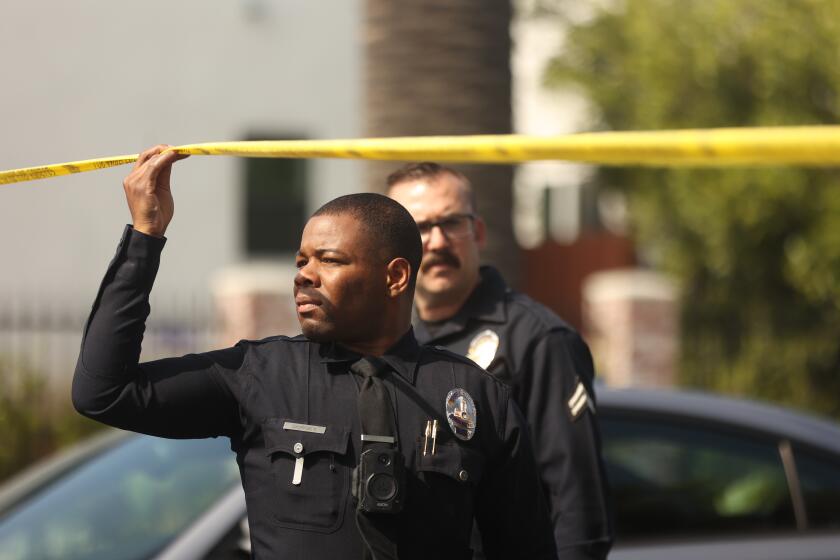Drive to Split L.A. Unified Dealt Setback
- Share via
The latest effort in the 20-year campaign to separate 200,000 San Fernando Valley schoolchildren from the Los Angeles school district suffered what may be a fatal blow Wednesday as state officials said it does not comply with state law and should not go on the ballot.
Under state law, a school district may not be split unless the breakup plan meets several tests. The new analysis by the staff of the state Department of Education says the Valley proposal fails on several grounds.
The plan would divide school facilities inequitably, disrupt instruction through the loss of magnet programs, increase crowding in middle and high schools, and lead to a shortfall in elementary classroom seats that would undermine the statewide class-size reduction initiative, the 26-page analysis asserts.
The proposal does not meet the law’s criteria and “no exceptional situation exists sufficient to justify approval,” the analysis said. “Accordingly, staff recommends the State Board of Education deny the proposal.”
After a public hearing scheduled for Dec. 6, the state board could still overrule the staff and place the breakup proposal on the ballot. But it is rare for the 11-member panel to go against staff recommendations.
The difficulty in getting a Valley school breakup proposal on the ballot illustrates the height of the hurdles facing any proposal to split up the nation’s second-largest school district. Many ideas have been floated in recent years, but no area has left the district since Torrance in 1948.
Earlier this month, a proposal to split off a 21,500-student district in Carson reached the ballot, but citizens in the South Bay city soundly rejected it.
The current breakup proposal would create two school districts of about 100,000 students each in the Valley, dividing the areas north and south, with Roscoe Boulevard serving as the primary boundary.
In addition to the staff analysis opposing the proposal, several board members have stated they are skeptical of establishing school systems for the Valley.
The board members’ comments have angered one of the chief proponents of the new districts, because the public hearing is still two weeks away.
“They’re supposed to wait and evaluate the evidence before they weigh in on it,” said Stephanie Carter, a leader of the citizens group Finally Restoring Excellence in Education, or FREE.
“That’s like a jury member walking out to the news and saying how they’re going to vote on a case when the case isn’t finished.”
If the proposal did make it to the ballot, it would face strong opposition from the district’s teachers’ union, which played a major role in defeating the proposed Carson district this month.
Dismantling the L.A. Unified is not the way to improve student achievement, teacher performance or parental satisfaction, said Bill Lambert, director of government relations for United Teachers-Los Angeles.
“What we really need to do is move ahead with all of the things we are trying to do to improve the system. We don’t see any benefit in breaking up the district,” he said.
Los Angeles school administrators, who have officially taken a neutral position on Valley school secession, said the breakup proposal is close to dead in the water.
“The whole point of the secession proposal was to improve education,” L.A. Unified Supt. Roy Romer said. “But the staff recommendation says it is not going to do that, and that it is going to have an adverse effect on programs.”
Backers of the plan must provide overwhelming evidence to persuade board members to reject staff recommendations and approve the secession proposal, said Fabian Nunez, L.A. Unified’s director of governmental affairs.
“The reasons for disapproving the proposal are so serious that it would be difficult for those who back Valley secession to make their case before the state board,” he said.
Despite the obstacle, Carter said FREE is focused on making a favorable impression before the state board because there is no appeal if the board turns down the plan.
“What we are trying to do is put this matter to a vote,” she said. “The question is: Do the people of the San Fernando Valley want two autonomous school districts? The only way to get that answered is to have an election. This has to be put to the people.”
Making that case may still be possible but difficult, said Nancy Ichinaga of Los Angeles, one of the board members. “The board will probably go along with whatever the staff recommends, generally that’s what happens,” she said. “But it really depends on what the other side comes up with. If they have a good case, they may sway some members.”
The staff report released Wednesday is the latest in a string of evaluations to find faults in FREE’s plan. The proposal, which could redefine public education in Southern California, has traveled a long road since its unveiling in 1997 by a grass-roots group seeking better public school educations for their children.
In the last four years, FREE has raised money for a petition drive and collected thousands of signatures of eligible voters in the Valley.
The plan was then reviewed in public hearings by the Los Angeles County Committee on School District Organization in February and March 2000. Three months later, that board rejected the plan on a 5-5 vote, with one member absent. The split vote was tantamount to a negative recommendation to the State Board of Education on whether the issue should be put before district voters.
The county committee and a private consultant raised concerns that breaking up the school system would leave the remaining Los Angeles district with a shortage of classrooms and money and would promote segregation.
The notion of at least one new school district in the Valley has been discussed on and off for more than 20 years. It was revived in its latest incarnation by former Assemblywoman Paula Boland amid a rising tide of local separatism.
Analyses of school district reorganizations in California examine at least nine criteria. For reorganizations affecting districts of 500,000 or more students, there are 10 more conditions. With 732,000 students, L.A. Unified is the state’s only district that large.
The drive to dismantle the Los Angeles public school system mirrors plodding campaigns in the Valley and Harbor area to secede from the city of Los Angeles. The Valley schools and government secession movements are so similar that they have often been confused by voters as a single issue.
Richard Close, a leader of the Valley VOTE cityhood movement, called the staff recommendations “unfortunate.”
“I would assume that FREE will go before the board and indicate how the staff concerns can be easily addressed,” he said. “Hopefully the state board will overturn the staff recommendations because those reasons are solvable. Ultimately, the Valley needs to have its own city, school and transit systems.”
The Department of Education’s analysis of Valley school secession was posted online Wednesday at https://www.cde.ca.gov/fiscal/dist_org/ sbeunification/sanfernandovalley.pdf.
More to Read
Sign up for Essential California
The most important California stories and recommendations in your inbox every morning.
You may occasionally receive promotional content from the Los Angeles Times.













